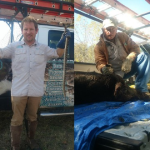Contrary to popular belief, moles are not rodents. They are rather more closely related to hedgehogs and shrews. That doesn’t make them any less of a hassle for humans, though. The solitary and subterranean mammals are found all around the United States and can destroy yards, gardens, and farm fields with their tunneling.
A homeowner's underground nightmare, moles are notorious for turning beautiful lawns into a series of tunnels and mounds. Though these creatures might be small, their impact is undeniably massive. As tireless burrowers, moles can cause significant damage to landscapes and structures. Read on to understand the nature of this elusive animal.
Appearance
General Characteristics
Moles are small, furry mammals with a pointed snout, tiny eyes, and large, powerful front paws that are designed for digging. Their bodies are streamlined for a life spent largely underground, with velvety fur that can lay flat in any direction, allowing them to move backward or forward in their tunnels with ease.
Coloration/Patterns/Distinctive Markings
Moles are typically of a solid gray or brown color. Their fur is dense and velvety, which not only helps them slide through the earth but also repels dirt and water. They don't have distinctive markings as such, but their shovel-like paws and reduced eyes and ears make them easily identifiable.
Size/Features
Most moles grow to about 6 to 8 inches in length, with some species being slightly larger or smaller. Their paws are their most significant feature, with strong claws that are perfect for digging.
Biology
Digestion and Diet
Moles are insectivores, feeding primarily on earthworms, insects, and larvae they find in the soil. They have a high metabolism and will eat more than half their body weight in food each day. Their saliva contains toxins that can paralyze small prey, making it easier for them to consume larger quantities at a time.
Reproduction
Female moles typically give birth to one litter per year, which consists of about 2 to 5 young. The babies are born blind and hairless but develop rapidly, ready to fend for themselves within a month or two.
Unique Sensory Systems
Though they have tiny eyes and weak vision, moles are sensitive to vibrations in the ground, which helps them detect prey. They also possess a keen sense of touch, especially on their snout, which aids in navigation underground.
Habitat
Preferred Environments
Moles are drawn to moist, rich soils abundant with their primary food sources: earthworms and insect larvae. This is why well-maintained gardens often become prime real estate for these critters.
Urban Encounters
While moles prefer natural habitats, the lush lawns and gardens of urban homes are enticing to them. This leads to frequent encounters between moles and homeowners, as their tunneling can quickly disrupt a manicured lawn.
Temperature Regulation
Moles spend most of their lives underground, where the temperature remains relatively consistent. This allows them to avoid extreme weather conditions and maintain their body temperature.
Behavior
Defensive Mechanisms
Moles will retreat into their tunnels when threatened. They don't possess significant means of defense, relying more on their elusive nature and the protection their underground habitat offers.
Burrowing Techniques
Their primary behavior is digging. Moles can create complex tunnel systems, some of which are used for hunting and others for nesting or resting. These systems can be extensive, often leading to the mounds and ridges seen on the surface.
Damage/Problems
Diseases
While moles aren't significant carriers of diseases harmful to humans, their activities can disturb the habitats of other animals that might.
Burrowing
Their burrowing habits can disrupt gardens, lawns, and even the foundations of structures if left unchecked.
Structural Damage
By undermining the ground, moles can cause soft spots, leading to potential damage or hazards, particularly in areas with structures or heavy foot traffic.
Trapping & Removal
Safe Handling
Handling moles requires experience and care. Without proper training, one might get bitten or injure the animal.
Relocation
Once caught, moles should be relocated to areas where their burrowing won't cause problems. This ensures a humane approach to mole problems.
Deterrence/Prevention
Property Maintenance
Regularly inspecting your property for mole activity and addressing issues promptly can mitigate extensive damage. Compacting soil or using repellents can also deter moles from making a home in your yard.
Physical Barriers
Underground barriers, like metal mesh, can prevent moles from burrowing into specific areas.
Educational Outreach
Informing communities about the habits of moles and preventative measures can reduce conflicts between humans and these small mammals.
Got a mole problem? AAAC Wildlife Removal are the experts you need! With a humane approach to every situation, we ensure that these little diggers are relocated safely, and your property remains pristine. Reach out to us for a consultation and let us help restore the beauty of your lawn and garden!



















































